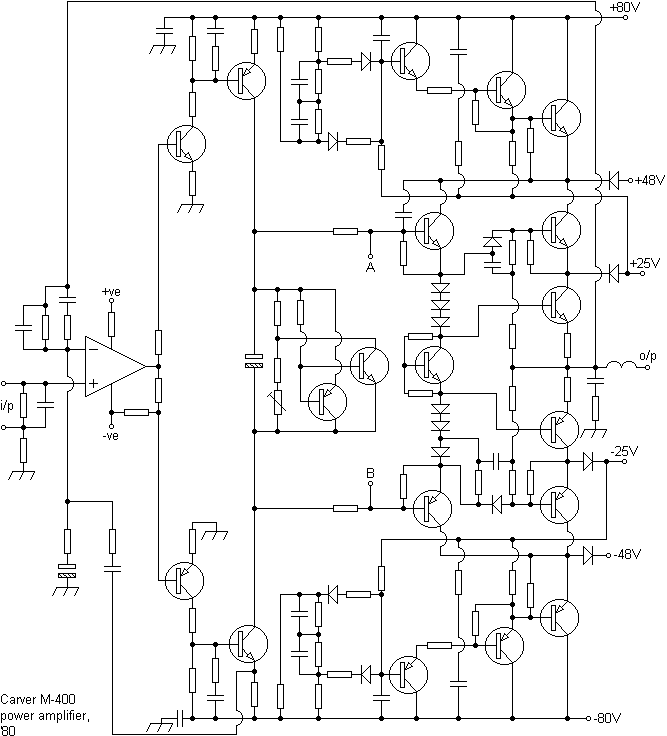
Carver Corporation M-400 MFA (Magnetic Field Amplifier)A new and excellent site has been set up by some techs and is well worth a visit.
An innovative attempt to reduce the bulk of the conventional amplifier was made with Bob Carvers' 1980 M-400 Magnetic Field Amplifier, where considerable attention was paid to reducing dissipation factors. The result offered 200W per channel (nearly 300W into 8R) from a 7" (approx) cube, weighing less than 9lbs. The term 'magnetic field amplifier' was a misnomer since, in reality, the M-400 did not amplify magnetic fields. Prior to the release of the production model a number of 'red herrings' had hinted at a far greater complexity.
Firstly, in a variation of class G, multiple output pairs were wired in series, each pair being fed from a separate power supply via a blocking diode. The level shifting diode chain starts to conduct before the transistors run into clipping, thus preventing any 'cross-over' effects. Although the first two pairs are driven by the signal, the final pair are just voltage sharing and conduct at all times. Quiescent dissipation is then reduced to about a third, the amplifiers' case being used as the heat-sink.

Secondly, the power supply was reconsidered, giving rise to terms of 'radical, exciting and original' from experienced professionals. The (switched) transformer windings were arranged to form a saturable coil known as a 'magnetic field core' (MFC), in appearance much like that of a normal 100VA E-I-laminated transformer. This inductor was used to store energy for very short periods, thereby fulfilling the roles of the reservoir capacitors (now much smaller).
Of the three power-supply rails, only those delivering current to the load will demand current from the MFC. In other words, the supply 'tracks' the demands of the signal. With a 15A mains fuse (for which the M-400 can develop an appetite) currents drawn could be very high, but being out-of-phase with the voltage overall power consumption was low.The operation of four protection circuits was summed turning the primarys' triac on and off.

The supply had a short time-constant rendering it 'safe' very quickly. At the same time, with a reasonably symmetrical signal, both amps draw current from opposing rails reducing the likelihood of dynamic crosstalk via the supply, and smoothing the demands on the MFC. Some users felt that the protection was too sensitive and had a nuisance value when the amplifier cut out on transients, say, as a stylus touched the record (simultaneous peaks on both supply rails).Other specs;
Power output (20Hz-20kHz, 1% THD max) = 300W into 8R, 200W into 4R (protection limited)
Dynamic power output (HF toneburst) = 320W/8R, 440W/4R and 420W/2R
THD (200W/8R) = 0.01% @ 20Hz, 0.006% @ 1kHz and 0.07% @ 20kHz
Sensitivity (for 200W/8R) = 1.25V
Signal-to-noise ratio (A-wtd, 1W/8R) = 82dB
Frequency response (-1dB, small signal) = 3Hz to 53kHzConsidered ground-breaking at the time, when other manufacturers (Sony, JBL and others) had dabbled with switched mode power supplies. With both amplifiers being wired anti-phase to each other, mono operation is easy. High frequency distortion was not the best and concerns were raised by the boxs' tendency to groan, squeak and buzz which some interpreted as a bad omen in respect of long-term reliability. In particular, with the high flux densities occuring in the much smaller 'transformer', now a fifth of the size of a conventional one. Being of non-standard construction, replacement would only be via the manufacturer. Others felt that problems would be exacerbated by cramming a large quantity of commercial grade components into a small volume and subjecting them to wide temperature and magnetic swings (the MFC, for example, had no copper strapping to reduce radiated hum). Notwithstanding high power paralleled outputs, component count-wise this rates as probably the most complex single output stage seen by the author. Does anybody have any data / experience concerning the life-span of these amps? If so, then
Contact me at paulkemble@hotmail.com
especially if you want additional content to this page
or if you find any links that don't work. Don't forget
to add the page title or URL. Take care!
Back to index, sound, tips or home.